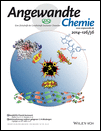Cell-Surface Engineering by a Conjugation-and-Release Approach Based on the Formation and Cleavage of Oxime Linkages upon Mild Electrochemical Oxidation and Reduction†
This research was supported by the Carolina Center for Cancer Nanotechnology Excellence (NCI), the Burroughs Wellcome Foundation (Interface Career Award), the National Science Foundation (Career Award), the National Science and Engineering Research Council of Canada (NSERC), and the Canadian Foundation for Innovation (CFI).
Abstract
We report a strategy to rewire cell surfaces for the dynamic control of ligand composition on cell membranes and the modulation of cell–cell interactions to generate three-dimensional (3D) tissue structures applied to stem-cell differentiation, cell-surface tailoring, and tissue engineering. We tailored cell surfaces with bioorthogonal chemical groups on the basis of a liposome-fusion and -delivery method to create dynamic, electroactive, and switchable cell-tissue assemblies through chemistry involving chemoselective conjugation and release. Each step to modify the cell surface: activation, conjugation, release, and regeneration, can be monitored and modulated by noninvasive, label-free analytical techniques. We demonstrate the utility of this methodology by the conjugation and release of small molecules to and from cell surfaces and by the generation of 3D coculture spheroids and multilayered cell tissues that can be programmed to undergo assembly and disassembly on demand.




